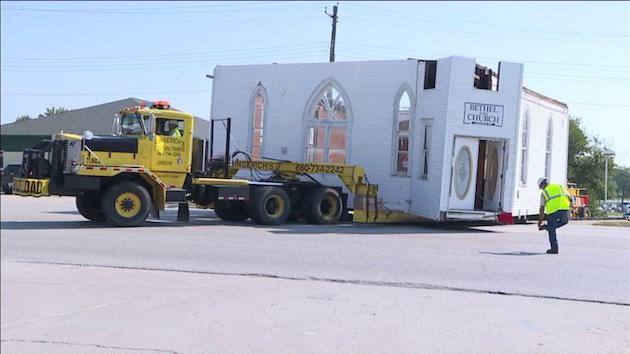A church believed to be the first African Methodist Episcopal Church located north of the Missouri River post-Civil War moved across the northern Missouri town of Chillicothe on Tuesday.
The Bethel AME Church was built and consecrated in 1868. It’s been a bedrock and local icon at 202 Henry Street ever since.

Bethel was the first AME church constructed and in 2010 became the last to close its doors.
The church has been vacant since then and was bought by a Chillicothe car dealership for additional parking space. The owner donated it to the Grand River Historical Society and Museum.
“It has 150 years of history. It’s part of the culture and heritage of the community,” Pamela Clingerman, the curator with the Grand River Historical Society and Museum told Kansas City Fox4 TV.
With the help of various agencies, the Bethel AME Church was moved from its 150-year-old residency at 202 Henry Street to McNally Street, which is adjacent to the historical society.
“This building is believed to have been the first African Methodist Episcopal Church built north of the Missouri River after the Civil War,” Clingerman said.
To prevent history from being lost, the owner donated the property to the museum.
“It would have been a loss of part of the history of Chillicothe,” said Frank Stark, a Chillicothe resident.
“We want to preserve the church as close as possible to what it was originally. We`re going to have it as a historic site in its own right, plus have exhibits on black history of the region,” Clingerman added.
It’s about 2 miles from point A to point B, but it took hours and some serious coordinating to get the church moved to its new home.
The church sanctuary, re-attached roof and steeple will be re-established on the new basement. The sanctuary will function as part of the museum, and the new basement will be used for classrooms and exhibit space.
“We`re known as the home of sliced bread, but we`re much bigger than that. So 150 years of history, that`s really important. It`s one of the oldest buildings in the community,” Clingerman said.
“If we don`t preserve things like that, our past is going to be gone, and no one will know it. Our past should be part of all of our lives, no matter what our age is,” Stark said.
Thanks to various foundations and private donations, the museum received thousands of dollars to make the move happen. But they are still short and are fundraising on the museum’s Facebook page.









